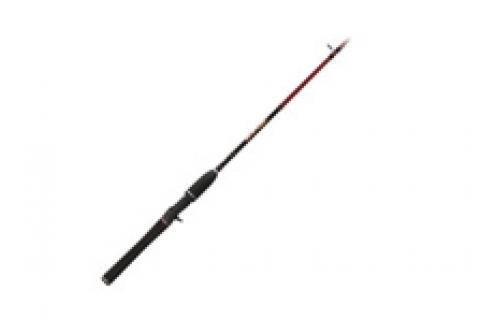
Let's face it. When it comes to bass fishing, getting the best fishing rod is pretty important. They allow us to cast our lures, work baits and, most importantly, haul in fish. But with all the bass rods saturating the market, how do you know which one is right for you? Choosing between spinning, casting and graphite can be so darn confusing, not to mention the long list of lengths and actions readily available for each and every model. Let's see if we can clear things up a bit for you.
Casting Rods

Casting rods are the meat and potatoes of the bass fishing world. Able to handle heavy line and big lures, this style of rod is most conducive to the heavy cover and power fishing situations you will come across.
Truth be told, 80 percent of my bass fishing is done with casting equipment. Without it, many of my favorite techniques — flipping, deep cranking, spinnerbaiting, topwater slop — just wouldn't be possible.
Although spinning rods have their time and place, most situations in bass fishing call for the use of heavier line and stout equipment to work lures efficiently and get fish to the boat. Take these key components out of the equation and your likely success as a bass angler drops considerably.
Although many anglers new to bass fishing approach casting reels with trepidation — mostly due to rumors of the dreaded "birds nest" — once learnt, they are tools that are easy and comfortable to use. And if you plan on tossing spinnerbaits, buzzbaits, crankbaits, jerkbaits, toads, big topwater baits, or pitching and flipping, embracing the casting rod is mandatory.
Spinning Rods
Although the brunt of the work is done with a casting rod, specific situations call for spinning gear. Skipping tubes under docks, working a shaky head, micro cranks and topwaters, as well as certain finesse-type techniques, all warrant the use of a spinning rod.
A rod of this stature will allow the use of light fishing line (line under 10# test or line with diameter equivalent to 10# test monofilament fishing line) and is better suited for smaller baits (usually 3/8 ounce or less). Their length and backbone can horse out most sized bass, but are best used in open water situations, away from heavy cover.
To simplify things, spinning rods are used for "non-power" fishing scenarios. Keep this in mind, and you'll have an easier time figuring out when best to use a rod of this type.
Bass Rod Materials
Most bass rods currently on the market are constructed from graphite. Graphite fishing rods like the Bass Pro Shops Graphite Series Spinning Rod are extremely lightweight, which creates a definite advantage for long days on the water. With this lightness comes extreme sensitivity, allowing an angler to feel every strike, bump or weed. This really comes into play for finicky fish, or when adverse weather conditions make "feel" that much more important.
Graphite rods are sometimes marked with a modulus rating. Contrary to popular belief, modulus ratings are not used to describe the number of graphite fibers incorporated into the rod blank, but rather a term used to describe the relative stiffness of the graphite. The higher the modulus rating, the stiffer the rod. Unless you are serious about crankbaiting, stick with graphite rods for all of your bass needs.
A composite rod is built with both graphite and fiberglass materials. Composite rods, often referred to as cranking rods, exhibit the lightness and sensitivity that is characteristic of graphite, while also providing the durability and "soft-tip feel" of fiberglass. Many bass anglers go with a composite rod for working crankbaits because it exhibits the necessary give when a fish strikes and isn't so stiff that you pull the hooks out on the initial hookset.
Many manufacturers are building composite rods specifically aimed at crankbait enthusiasts. If cranking is one of your favorite techniques, and composite rod is worth a look.
The Action of a Fishing Rod

The action of a rod is a term used to describe the flexibility or stiffness that it exhibits.
Extra Fast — This style of fishing rod will bend very little, only in the upper tip. A rod of this type is ideal for fishing heavy cover — slop, docks or wood — when getting the fish up and away from cover is paramount to your success. The faster the action, the more pressure you can put on a bass.
Fast Action —A fast action rod will bend in the upper 25 to 30 percent. They provide both power and flex, which is essential when throwing spinnerbaits, soft sticks, jerkbaits and topwaters.
Moderate Action —These rods will bend near the middle. A moderate action will also cast lures easier than a fast or extra-fast action, due in part to the rod loading. Ideal for light line and finesse tactics.
Power Rating the Overall Rod Strength
The power rating describes the rods overall strength. Power ratings start at ultra light and peak at extra heavy, but for bass fishing, a medium, medium/heavy, heavy or extra heavy power rating will cover almost all situations you come across, as well as the lures you toss. The higher the power rating, the heavier the lures you're able to toss; rods with a lower power rating cast light lures better, but don't always have the backbone to handle big bass.
Fishing Rod Guides
Rod guides are an integral part of the rod design. Quality guides help ensure long casts and reduced line in friction. Proper guide placement helps spreading out the stress applied to the blank when fighting a bass.
Ceramic or titanium guides both do an excellent job and are of the utmost quality. A few of the more popular guides on the market are Fuji's Hardloy, Silicon Carbide and REC Nickel Titanium Recoil.
- 216480 views

